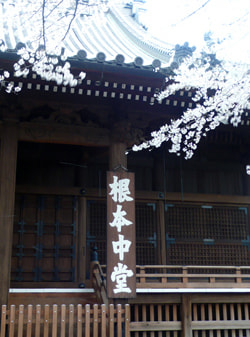
Ueno Kan-eiji Temple
At the monk Tenkai's (Jigen Daishi) suggestion, the living quarters of Kan-eiji Temple, or Toeizan Kan-eiji Temple of the Tendai Sect of Buddhism, was founded in 1625 as a guardian temple, which protects the northeastern quarter of Edo Castle. "Toeizan" means the east "Hieizan." The temple was named "Kan-eiji" because it was built in the Kan-ei Era. The temple flourished as the family temple of the Tokugawa shoguns, graves of which are also located in Zojoji Temple, and had the Endon-in quarters and some smaller temples in its precincts. However, most of them were burnt down during so-called "Battle of Ueno," which was fought in 1868 between the government army and the Shogitai. The main hall of the temple was originally located at Kitain Temple in Kawagoe City and later moved to the present location in 1879. (Ueno Sakuragi 1-chome, Taito City)

Kan-eiji Temple
Nothing gives more evidence of the great change from the Edo to Meiji Period and the history of Taisho and Showa Periods than the woods of Ueno. Kan-eiji Temple has always been the center of that history. The temple prospered as the family temple of the Tokugawa shoguns, and the Ueno area was thronged as a temple town in the Edo Period. "Hundred View of Edo" painted by Hiroshige Utagawa (Hiroshige Ando) captures the mood of bustle.
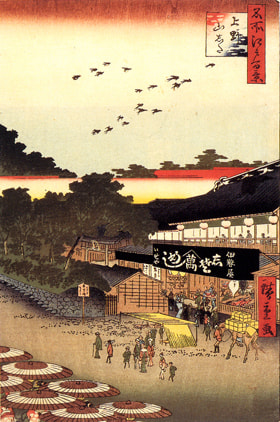
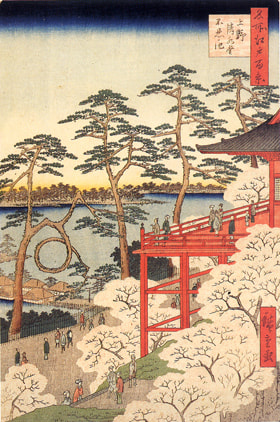
Hiroshige Utagawa, "Meisho Edo hyakkei: Ueno Kiyomizu-do Shinobazu no ike"

A view of the Hongo area through the circular branch of "Tsuki-no Matsu," a pine tree planted near Ueno Benzaiten Shrine. The pine tree in the foreground is depicted as having a unique form, and its expression is also superb.
Ueno was a pleasure resort in Edo.
No place has been more bustling than the woods of Ueno since the Edo Period. Shinobazu-no Ike Pond was created in imitation of the landscape of Mt. Hiei and Lake Biwa. Shrines and temples were built one after another by the successive shoguns. People visited Ueno, indulged themselves in a luxuriant greenery, admired colossal temples and enjoyed strolling. In their way home, they relished the bustle of the Ueno Yamashita and Yanaka areas. Ueno was like a big amusement park.

Kan-eiji Temple (From the right - Kuromon, Sannosha, Kiyomizudo and Niomon. Shinobazu-no Ike Pond lies in the foreground.)
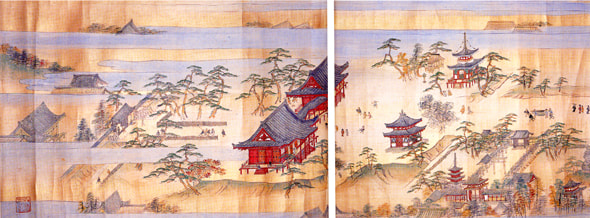
Kan-eiji Temple (From the right - great statue of buddha, Ueno Toshogu, five-storied pagoda, two-storied pagoda, scripture house, Ninaido and main hall), "Jigen Daishi Engi Emaki" by Gukei Sumiyoshi (portion, owned by Kan-eiji Temple, an art treasure), "Jigen Daishi Engi Emaki" by Gukei Sumiyoshi (portion, owned by Kan-eiji Temple, an art treasure)
Picture scrolls depicting the foundation of Kan-eiji Temple, which were painted by Gukei Sumiyoshi, an official Japanese-style painter in the shogun's court. This work consists of three scrolls, including one depicting Jigen Daishi (Tenkai), a founder of Kan-eiji Temple.

Mushizuka (a historic site designated by Tokyo) Kan-eiji Temple
Mushizuka was built in 1821 by bequest of Sessai Masuyama, a feudal lord of Ise Nagashima (present-day Mie Prefecture), in order to console the sprit of dead insects which were used as models for drawings. Sessai interacted with many literatus such as Nanbo Ota, and was active as a patron of them. He also mastered the art of realistic painting of Nanpin-ha School in China, and produced many paintings of flowers and birds. Among them, "Chu-chi Jo," a picture book of insects, is especially famous for its minuteness and accuracy.
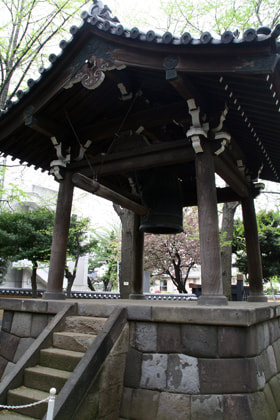

Ueno Kan-eiji Temple
At the monk Tenkai's (Jigen Daishi) suggestion, the living quarters of Kan-eiji Temple, or Toeizan Kan-eiji Temple of the Tendai Sect of Buddhism, was founded in 1625 as a guardian temple, which protects the northeastern quarter of Edo Castle. "Toeizan" means the east "Hieizan." The temple was named "Kan-eiji" because it was built in the Kan-ei Era. The temple flourished as the family temple of the Tokugawa shoguns, graves of which are also located in Zojoji Temple, and had the Endon-in quarters and some smaller temples in its precincts. However, most of them were burnt down during so-called "Battle of Ueno," which was fought in 1868 between the government army and the Shogitai. The main hall of the temple was originally located at Kitain Temple in Kawagoe City and later moved to the present location in 1879. (Ueno Sakuragi 1-chome, Taito City)
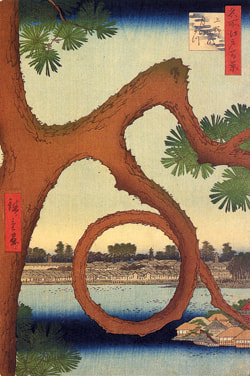
A view of the Hongo area through the circular branch of "Tsuki-no Matsu," a pine tree planted near Ueno Benzaiten Shrine. The pine tree in the foreground is depicted as having a unique form, and its expression is also superb.















